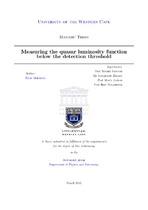| dc.contributor.advisor | Santos, Mario | |
| dc.contributor.advisor | Zwart, Jonathan | |
| dc.contributor.advisor | Jarvis, Matt | |
| dc.contributor.advisor | Maartens, Roy | |
| dc.contributor.author | Malefahlo, Eliab | |
| dc.date.accessioned | 2016-05-10T14:38:51Z | |
| dc.date.available | 2016-05-10T14:38:51Z | |
| dc.date.issued | 2016 | |
| dc.identifier.uri | http://hdl.handle.net/11394/4956 | |
| dc.description | >Magister Scientiae - MSc | en_US |
| dc.description.abstract | The radio emission of radio-quiet active galactic nuclei (AGN) is thought to be from star formation and AGN related emission. I investigate these sources using 1.4 GHz radio data from FIRST and three optical quasars samples from the SDSS: (i) a volume-limited sample in the redshift range 0:2 < z < 0:4 defined by Mi < -23 (ii) magnitude-limited sample in the redshift range 1:8 < z < 2:5 defined by mr ≤ 18:5 and (iii) a uniform sample in the redshift range 0:2 < z < 3:5 (divided into 12 redshift bins). I constructed radio source counts and radio luminosity functions (RLFs) using the optical quasars detected in FIRST, which are consistent with literature results obtained using SDSS and NVSS quasars. There are differences at the low uxs end because of the different resolutions of FIRST and NVSS. I applied a median stack method to the 12 redshift bins of the uniform sample and found that the median ux decreases from 182 µJy in the lowest redshift bin to 39 µJy and the
highest redshift bin. This is because the high redshift quasars although more luminous than their low redshift counterparts, they are much further away so they have lower uxes. I probed the quasar radio source counts to lower levels using reconstructed source counts obtained by applying the Bayesian stack technique. The reconstructed radio source counts were then used to constructed the quasar
RLF to lower levels, where I found: (i) for z < 1 the constructed quasar RLF has the same slope as the detected quasars, suggesting that like the detect quasars their radio emission is dominated by AGN related emission (ii) above z = 1 the constructed RLF steepens with redshift, which suggests the strong link between accretion rate and radio jet power is gradually breaking down towards faint
optical luminosities at high redshift. | en_US |
| dc.description.sponsorship | National Astrophysics and Space Science Program (NASSP) and SKA Africa | en_US |
| dc.language.iso | en | en_US |
| dc.publisher | University of the Western Cape | en_US |
| dc.subject | Galaxy formation | en_US |
| dc.subject | Galactic processes | en_US |
| dc.subject | Radio-quiet | en_US |
| dc.title | Measuring the quasar luminosity function below the detection threshold | en_US |
| dc.rights.holder | University of the Western Cape | en_US |

